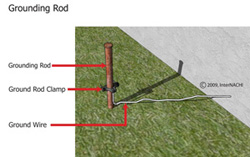Electrical Grounding Safety For Workers and Equipment

Electrical grounding safety is a critical component of electrical system design that protects workers, the public, and equipment from hazardous electrical faults. In both the United States and Canada, grounding practices are regulated by national codes—NFPA 70 (National Electrical Code) and CSA C22.1 (Canadian Electrical Code)—which define how systems must be grounded to ensure safe operation under normal and fault conditions. Grounding works by connecting electrical systems to the earth, allowing stray or fault current to safely dissipate, reducing the risk of shock, fire, and equipment damage. Utilizing appropriate Electrical Safety Testers ensures the effectiveness of these grounding systems.
Request a Free Training Quotation
Grounding is not optional—it is a legal and safety requirement. Electrical accidents related to poor grounding can result in injuries, equipment failures, and even fatalities. This is why both NFPA 70E in the U.S. and CSA Z462 in Canada emphasize grounding as part of a comprehensive electrical safety program, especially in environments where arc flash or high-voltage exposure is a risk.
The Role of Grounding in Electrical Safety
At its core, grounding protects people and systems by directing unwanted electricity away from users and sensitive components. Faults such as insulation failure, accidental contact with energized parts, or lightning strikes can introduce dangerous current into systems. A properly grounded system channels this current into the earth, minimizing the chance of electric shock or fire.
In residential, commercial, and industrial settings, the grounding system acts as the baseline reference point for all voltages in the system. It ensures circuit breakers or fuses respond quickly to faults by providing a low-impedance path for current to return to its source, thus enabling automatic disconnection.
Without grounding, workers servicing energized systems could become the path of least resistance for current flow. Understanding High Voltage Electrical Safety is crucial in these scenarios. In such cases, electrical current may pass through the human body—particularly the heart—causing severe or fatal injuries. Water, concrete, and even soil can also conduct electricity, which is why the earth itself becomes a critical safety component in grounding systems.
Improving Protection Through Grounding Systems
Proper grounding not only improves personnel safety but also enhances the reliability of electrical infrastructure. Sensitive electronic equipment can be damaged by transients or voltage surges, such as those caused by lightning or switching operations. Grounding stabilizes system voltage during these events and provides a safe path for discharge.
Moreover, electrostatic discharge (ESD) can accumulate on equipment and personnel in dry environments. If not properly grounded, this static buildup can lead to dangerous sparks or damage to components. Grounding systems dissipate these charges safely and continuously.
In both the U.S. and Canada, industrial facilities and data centers often install redundant or enhanced grounding systems to protect mission-critical operations. Utility substations and high-voltage installations incorporate ground grids and rods, which are calculated and tested for soil resistivity to ensure adequate performance under all conditions.
Components of a Grounding System
An effective grounding system consists of several key components, each performing a specific function within the overall protective scheme. These include:
- Grounding Electrode Conductor (GEC): Connects the system to the earth via grounding electrodes such as rods, plates, or grounding rings.
- Grounded (Neutral) Conductor: Tied to the system’s zero-voltage reference point, often connected at the main service panel.
- Equipment Grounding Conductor (EGC): Bonds non-current-carrying metal parts of equipment to prevent accidental energization.
- Ground Bus Bars and Bonding Jumpers: Ensure electrical continuity between different grounding elements and enclosures.
These elements must be installed to code, using properly sized conductors, corrosion-resistant connections, and minimal impedance paths. The NEC Article 250 and Section 10 of the Canadian Electrical Code provide specific rules for selecting and installing grounding systems.
A Foundation for Electrical Safety
Electrical grounding safety is foundational to protecting people and infrastructure across North America. With ongoing technological advancements, the grounding system remains one of the simplest yet most effective defenses against electrical hazards. Both U.S. and Canadian electrical codes mandate grounding not only as a best practice but as a legal requirement in nearly all installations.
Workers must be trained to understand grounding principles as part of a larger electrical safety culture. In fact, both NFPA 70E Arc Flash Training and CSA Z462 training programs emphasize the role of grounding in hazard mitigation and safe work practices.
Whether you're in a residential setting, a manufacturing plant, or a utility substation, grounding should never be an afterthought—it’s the first line of defense when electricity goes wrong.
Arc Flash Group Training

We can present this Course to your electrical engineering and maintenance staff, on your premises, tailored to your specific equipment and requirements. We are ready to help design this program for you. Click on the link below to request a FREE quotation.
Live Online Electrical Training Schedule
October 2025
- Grounding and Bonding Training And The CE Code
- Arc Flash Training - CSA Z462 Electrical Safety
- Combined CSA Z462 LV & HV Electrical Safety Training
- High Voltage Safety Training
- NFPA 70e Training
- Substation Maintenance Training
November 2025
- Power Transformer Maintenance Training
- NFPA 70b Training - Electrical Maintenance
- Emergency Generators & Standby Power Systems
- 2024 CE Code - Changes and Fundamentals
- 2024 CE Code - Combined Course: Changes/Fundamentals and Calculations
- Lightning Protection Systems Training For Utility, Industrial, Commercial & Institutional power systems
